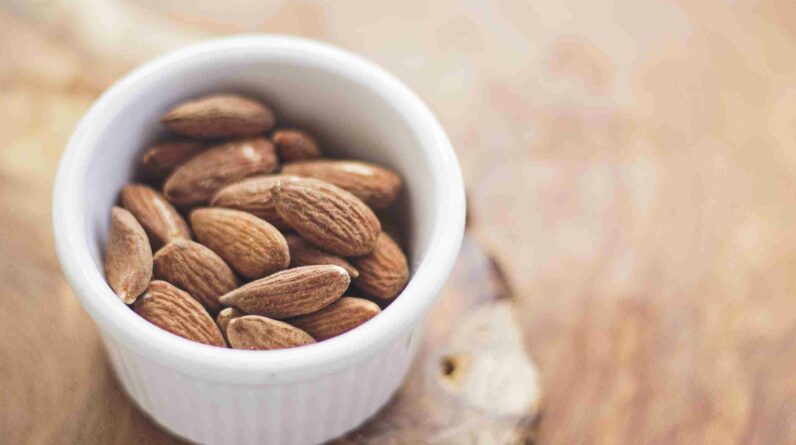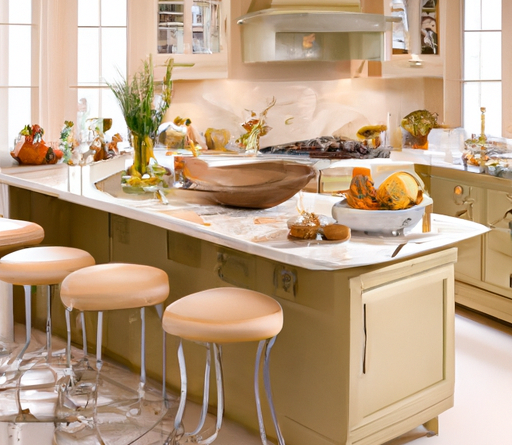Are you tired of battling a never-ending war against kitchen clutter? Look no further! In this article, we will share some fabulous tips and tricks to help you minimize the clutter in your kitchen. From clever storage solutions to practical organizing techniques, we have got you covered. Say goodbye to chaotic countertops and hello to a serene and tidy cooking space. So, roll up your sleeves and let’s get started on the path to a clutter-free kitchen!
1. Decluttering and Organizing Kitchen Cabinets
1.1 Empty and Clean Cabinets
When it comes to decluttering and organizing kitchen cabinets, the first step is to empty them completely. This allows you to assess the amount of space you have and gives you a fresh start to rearrange items more efficiently. Once the cabinets are empty, take the time to clean them thoroughly. Wipe down the surfaces, remove any crumbs or debris, and make sure the shelves are dry before placing items back inside.
1.2 Sort and Categorize Items
After cleaning the cabinets, it’s crucial to sort and categorize the items before putting them back. Grouping similar items together not only makes it easier to find what you need but also maximizes the available space. You can categorize items such as plates, cups, bowls, and cookware. Sorting items not only allows for easier organization but also helps identify any duplicates or items that you no longer use.
1.3 Get Rid of Unused or Duplicate Items
As you sort through your kitchen items, it’s essential to get rid of any unused or duplicate items. Duplicates take up valuable cabinet space, so if you have multiple items of the same kind, consider donating or giving away the extras. Additionally, if there are any items that you no longer use or that are broken or damaged, it’s time to say goodbye to them. This decluttering process will help create a more streamlined and efficient kitchen.
1.4 Use Cabinets Efficiently
To make the most out of your kitchen cabinets, it’s important to use them efficiently. One way to do this is by utilizing vertical space. Install additional shelves or stackable organizers to maximize the height of your cabinets. You can also use under-cabinet hooks or racks to hang mugs or utensils. Additionally, consider using dividers or organizers within the cabinets to keep items neat and easily accessible. By using your cabinet space efficiently, you’ll have more room for storing your kitchen essentials.
1.5 Utilize Organizational Tools
There are various organizational tools available that can help you keep your kitchen cabinets organized. For smaller items such as spices or packets, consider using drawer organizers or small baskets. Clear storage containers can be used to store dry goods such as flour, sugar, or pasta, making it easier to see the contents and prevent spills. Another useful tool is a lazy susan, which can be placed in corner cabinets to maximize storage space and provide easy access to items. These organizational tools can greatly simplify the task of finding and retrieving items from your kitchen cabinets.
2. Streamlining Countertop Space
2.1 Clear off the Countertops
A cluttered countertop can make your entire kitchen feel disorganized and cramped. To streamline your countertop space, start by clearing it off completely. Remove any appliances, decorative items, or miscellaneous objects that are not used daily. By having a clear surface, you’ll have more room for meal preparation and a visually appealing space that is easier to clean.
2.2 Evaluate Essential Kitchen Tools
Take a careful look at the appliances and tools you currently have on your countertop. Ask yourself if each item is essential and if it is used frequently. Consider moving appliances that are used less often to a storage area or cabinets. Keep the items that you use frequently within reach, such as a coffee maker or toaster, but store them in an organized manner to prevent clutter.
2.3 Find Proper Storage Solutions
Finding proper storage solutions for your essential kitchen tools is key to keeping your countertops clutter-free. Utilize cabinets or drawers near your countertop to store appliances or tools that are not used daily. You can also invest in storage racks or hooks that can be mounted on the inside of cabinet doors to hang utensils or small pots and pans. By having designated storage areas, you can keep your countertops clear while still having easy access to the items you use regularly.
2.4 Invest in Multi-purpose Appliances
To further streamline your countertop space, consider investing in multi-purpose appliances. For example, a blender that also functions as a food processor can save you valuable space by eliminating the need for two separate appliances. Similarly, a toaster oven that can double as a regular toaster and a mini-oven can serve multiple purposes without taking up extra counter space. By selecting appliances with multiple functions, you can minimize clutter and maximize the efficiency of your kitchen.
2.5 Utilize Wall or Vertical Space
If you find that you still need more countertop space, consider utilizing wall or vertical space. Install shelves or hooks on the walls to store items such as pots, pans, or cooking utensils. Magnetic strips can be attached to the wall to hold knives or metal utensils. By using wall or vertical space, you can free up valuable countertop real estate and create a more organized and functional kitchen.

3. Managing Pantry and Food Storage
3.1 Assess and Discard Expired or Unused Items
A cluttered and disorganized pantry can make it challenging to know what food items you have and can result in wasted items. To manage your pantry effectively, start by assessing and discarding any expired or unused items. Check food labels for expiration dates and dispose of any items that are no longer safe to consume. Additionally, consider donating non-perishable items that are still within their expiration dates but are unlikely to be used by your household.
3.2 Group Items by Categories
Once you have cleared out any expired or unused items, group your pantry items by categories. Create sections for canned goods, baking supplies, grains, snacks, and so on. By categorizing your items, you’ll be able to quickly find what you need and maintain a well-organized pantry.
3.3 Use Clear Containers or Jars
Using clear containers or jars to store dry goods in your pantry has several benefits. Firstly, it allows you to easily see the contents of each container, helping you quickly identify what you have and what you need to restock. Secondly, using containers helps keep items fresh and prevents pests from getting into your food. Consider transferring items such as pasta, rice, flour, and sugar into clear, airtight containers to prolong their shelf life and keep your pantry organized.
3.4 Label Shelves and Containers
Labeling shelves and containers in your pantry is another effective way to maintain organization. Use adhesive labels or a label maker to clearly identify each section or container. This not only makes it easier for you to find what you’re looking for, but it also helps other members of your household know where items should be returned after use, reducing the risk of items being misplaced or forgotten.
3.5 Consider Efficient Shelving Systems
If your pantry has limited space or odd-shaped shelves, consider investing in efficient shelving systems. Adjustable wire or stackable shelves can help maximize vertical space and provide additional storage options. Sliding drawers or baskets can also be installed to make it easier to access items stored towards the back of deep shelves. By optimizing your pantry’s shelving systems, you can make the most out of the available space and ensure everything is easily accessible.
4. Organizing Utensils and Cookware
4.1 Purge Unnecessary Utensils
When it comes to organizing utensils and cookware, the first step is to purge any unnecessary items. Determine which utensils you use regularly and which ones are gathering dust. Donate or give away utensils that you no longer need or use. By doing this, you’ll free up valuable drawer or countertop space and have a more streamlined collection of utensils.
4.2 Organize Utensils by Type
Once you have purged unnecessary utensils, it’s time to organize the remaining ones. Organize utensils by type, such as spatulas, whisks, or tongs. Use drawer dividers or inserts to keep similar utensils together and prevent them from getting tangled or mixed up. This organization makes it easier to find the utensil you need and keeps your drawers neat and clutter-free.
4.3 Utilize Drawer Dividers or Inserts
Drawer dividers or inserts are an excellent tool for organizing utensils and keeping them neatly separated. They provide designated spaces for different types of utensils, ensuring that each item has its place. Dividers or inserts also make it easier to see and access your utensils, preventing them from becoming a jumbled mess in your drawer. Consider investing in adjustable dividers or inserts to accommodate various utensil sizes and optimize your drawer space.
4.4 Hang Pots and Pans
Hanging pots and pans is an effective way to save cabinet space and keep your cookware organized. Install a pot rack or hanging hooks on a wall or ceiling to create a designated space for your pots and pans. This not only frees up cabinet space but also makes it easier to access and retrieve the cookware you need. Ensure that the pots and pans are securely hung to avoid any accidents.
4.5 Utilize Space-Saving Cookware
Another way to maximize your storage space is by using space-saving cookware. Opt for nesting pots and pans that stack neatly inside each other, minimizing the amount of space they take up when not in use. Additionally, consider investing in collapsible or foldable cookware, such as measuring cups or colanders, that can be easily stored in a compact manner. These space-saving options allow you to make the most of your available storage space while still having all the cookware you need.

5. Maximizing Refrigerator and Freezer Efficiency
5.1 Clean and Remove Expired Items Regularly
To maximize efficiency in your refrigerator and freezer, regular cleaning and removing expired items is essential. Set aside time each month to thoroughly clean the interior of your refrigerator and freezer. Remove any expired or spoiled food items, wiping down shelves and drawers as you go. Regular cleaning not only keeps your fridge fresh but also makes it easier to see and access the items you have.
5.2 Organize Items by Categories
Organizing items in your refrigerator and freezer by categories helps you quickly locate what you need and prevents food from getting lost or forgotten. Group similar items together, such as dairy products, meat, fruits, and vegetables. Consider using bins or clear storage containers to further organize items, keeping them neatly separated and preventing spills or leaks from spreading.
5.3 Use Transparent Bins or Trays
Using transparent bins or trays in your refrigerator and freezer is a practical way to keep items organized and easily accessible. Place items such as condiments, small fruits, or cheeses in separate bins or trays. This keeps them visible and prevents smaller items from getting lost in the back of the fridge. Make sure to label the bins or trays if necessary, to further enhance organization and efficiency.
5.4 Utilize Fridge and Freezer Door Space
The door space in your refrigerator and freezer is often underutilized but can be valuable storage real estate. Use this space to store items such as condiments, butter, or drinks that are frequently accessed and have a longer shelf life. Install door shelves or organizers to maximize the available space and keep items neatly arranged. Just be mindful not to overload the door as excessive weight can affect the door’s seal and temperature regulation.
5.5 Utilize Lazy Susans or Turntables
Lazy Susans or turntables are useful tools to maximize the efficiency of your refrigerator and freezer. They allow you to rotate items and access them easily, even if they are stored towards the back of the shelf. Use a Lazy Susan or turntable in your fridge to store items such as jars or dressings, and in your freezer for bags of frozen fruits or vegetables. This simple addition can help prevent items from being forgotten or wasted and keeps your fridge and freezer organized.
6. Managing Small Appliances and Gadgets
6.1 Determine Essential Appliances and Gadgets
Managing small appliances and gadgets starts with determining which ones are essential to your daily kitchen routine. Consider which appliances and gadgets you use frequently and are integral to your cooking process. Weed out any items that are duplicative or rarely used to minimize clutter.
6.2 Store or Display Them Efficiently
Once you have identified your essential appliances and gadgets, it’s important to store or display them in an organized and efficient manner. Store appliances that are used less frequently in cabinets or cupboards to free up countertop space. For frequently used items, consider keeping them on display but still organized. Use appliance garages or designated shelves to keep them easily accessible but off the countertop.
6.3 Utilize Vertical Wall Space
To make the most of your kitchen space, utilize vertical wall space for storing small appliances and gadgets. Install shelves or hooks on the walls to hang items such as blenders, mixers, or toasters. This not only keeps the countertops clear but also adds a decorative touch to your kitchen while keeping your appliances easily accessible.
6.4 Make Use of Appliance Garages
Appliance garages are an excellent investment to keep small appliances organized and hidden from sight. These countertop cabinets can be opened or closed as needed, allowing you to store appliances such as coffee makers, toasters, or juicers out of sight when not in use. Appliance garages are a great way to minimize clutter and keep your kitchen looking tidy.
6.5 Minimize Clutter with Cord Organization
Cord organization is essential in managing small appliances and gadgets. Excess cords can create visual clutter and become a tangled mess, making it difficult to use or store appliances. Use cord management solutions such as cable ties or cord clips to keep cords neatly wrapped and secured. Labeling cords with adhesive tags or color-coded labels can also make it easier to identify which cord belongs to which appliance. By keeping cords organized, you’ll minimize visual clutter and maintain a more organized kitchen.

7. Controlling Paper Clutter
7.1 Create a Paper Organization System
Paper clutter can easily accumulate in the kitchen, with incoming mail, receipts, and other documents. To control the paper clutter, create a paper organization system. Designate a specific area or folder for incoming mail and establish a routine for sorting through it regularly.
7.2 Sort Mail and Documents Regularly
To prevent paper clutter from piling up, it’s important to sort mail and documents regularly. Set aside time each week to go through your mail, sorting it into different categories such as bills, invitations, or important documents. Recycle or shred any unwanted or unnecessary papers promptly to avoid letting them accumulate.
7.3 Utilize Digital Tools and Apps
Minimize the amount of paper clutter in your kitchen by utilizing digital tools and apps. Scan important documents and save them digitally instead of keeping physical copies. Use online bill pay services to receive and pay bills electronically, reducing the need for paper statements. Explore digital recipe apps or websites for storing and accessing your favorite recipes without the need for physical cookbooks or printed recipes.
7.4 Opt for Paperless Options
Whenever possible, opt for paperless options to minimize paper clutter. Choose to receive electronic receipts rather than printed ones when shopping or dining out. Sign up for online newsletters or subscriptions instead of physical mailings. By reducing the amount of paper that enters your kitchen, you’ll have less clutter to manage.
7.5 Keep a Small Recycling Bin Nearby
To quickly dispose of any unwanted paper clutter, keep a small recycling bin or shredder nearby in your kitchen. This encourages the habit of promptly discarding unnecessary papers and reduces the chances of them piling up on counters or in drawers. Make sure to empty the recycling bin regularly to maintain a clutter-free kitchen.
8. Simplifying Dishwashing and Sink Area
8.1 Use a Dish Rack for Drying
A dish rack is an essential tool for simplifying the dishwashing process and keeping your sink area organized. After washing dishes, place them in a dish rack to air dry instead of cluttering the countertop. Consider choosing a dish rack with separate compartments or slots to organize dishes, utensils, and glasses, allowing them to dry efficiently.
8.2 Declutter Sink and Countertop
Keep your sink and countertop clutter-free by decluttering regularly. Rinse and place dirty dishes directly into the dishwasher or soak them in a designated dish tub, reducing the amount of clutter in or around the sink. Avoid using the sink or countertop as a general dump for miscellaneous items by finding proper storage places for them.
8.3 Store Cleaning Supplies Properly
To simplify dishwashing and maintain an organized sink area, make sure to store your cleaning supplies properly. Keep dish soap, scrub brushes, and sponges in a designated area near the sink, such as under the sink or in a caddy. This ensures that everything you need for dishwashing is easily accessible and prevents unnecessary clutter.
8.4 Utilize Sink Accessories and Organizers
To maximize the efficiency of your sink area, utilize sink accessories and organizers. Sink caddies or baskets can be used to hold sponges and brushes, keeping them neatly contained and minimizing clutter. Over-the-sink cutting boards or colanders are also practical options that provide extra workspace and utilize the sink area effectively.
8.5 Establish a Dishwashing Routine
Establishing a dishwashing routine can greatly simplify the process and keep your sink area tidy. Make a habit of washing dishes immediately after use or designating specific times of the day for dishwashing. By staying on top of the dirty dishes and implementing a routine, you can prevent them from piling up and cluttering your sink area.
9. Implementing Daily Cleaning Habits
9.1 Wipe Down Countertops After Each Meal
To maintain a clean and organized kitchen, make it a habit to wipe down the countertops after each meal. Use a cleaning spray or wipe to quickly remove any crumbs or spills. This simple daily task prevents residue from building up and keeps your countertops looking tidy and inviting.
9.2 Regularly Sweep or Vacuum the Floor
A clean and clutter-free kitchen includes the floors. Make it a habit to regularly sweep or vacuum the kitchen floor to remove any loose dirt or debris. This prevents debris from being tracked throughout the kitchen and makes the space feel cleaner and more organized.
9.3 Clean Appliances Regularly
Keeping your appliances clean not only improves their performance but also contributes to an organized kitchen. Regularly clean your oven, stovetop, microwave, and other appliances according to their specific cleaning instructions. Wipe down the exterior surfaces of appliances to remove any grease or spills. By incorporating regular appliance cleaning into your routine, you’ll maintain a tidy and well-functioning kitchen.
9.4 Empty and Clean Trash and Recycling Bins
Emptying and cleaning your trash and recycling bins on a regular basis is essential to avoid unpleasant odors and keep your kitchen organized. Make it a habit to empty the bins when they become full or at least once a week. After emptying, wipe down the bins with a disinfectant cleaner to keep them fresh and free from bacteria.
9.5 Establish a Weekly Cleaning Schedule
Establishing a weekly cleaning schedule ensures that all areas of your kitchen receive regular attention and stay organized. Assign specific tasks for each day of the week, such as cleaning the fridge on Mondays, wiping down cabinets on Tuesdays, and so on. Having a weekly cleaning schedule simplifies the cleaning process and prevents tasks from being overlooked or neglected.
10. Maintaining a Clutter-Free Environment
10.1 Regularly Reassess and Declutter
Maintaining a clutter-free kitchen requires regular reassessment and decluttering. Set aside time every few months to reassess the items in your kitchen and determine if there are any that can be decluttered or donated. Over time, our needs and preferences can change, so getting into the habit of regular reassessment helps keep your kitchen organized and reflects your current lifestyle.
10.2 Minimize Impulse Purchases
To prevent clutter from entering your kitchen in the first place, make a conscious effort to minimize impulse purchases. Before buying a new kitchen gadget or accessory, consider if it is truly necessary and if it will serve a purpose in your kitchen. By avoiding unnecessary purchases, you’ll prevent your kitchen from becoming overcrowded with items that are seldom used.
10.3 Establish Sustainable Habits
Sustainable habits not only benefit the environment but also contribute to a clutter-free kitchen. Opt for reusable containers instead of single-use plastic wraps or bags. Use kitchen towels or cloth napkins instead of disposable paper towels. By incorporating sustainable habits into your daily routine, you’ll reduce waste and the potential for kitchen clutter.
10.4 Involve the Entire Household
Maintaining a clutter-free environment is a team effort, so involve the entire household in the process. Encourage family members to clean up after themselves and put items back in their designated places. Teach children to follow proper kitchen organization and cleaning routines. By involving everyone, you’ll create a shared responsibility and a more organized kitchen.
10.5 Seek Inspiration and Resources
Seeking inspiration and utilizing available resources can greatly assist in maintaining a clutter-free kitchen. Browse home organization websites, magazines, or books for tips and ideas on efficient kitchen organization. Use online platforms or social media groups to connect with others who are also seeking to maintain an organized kitchen. By seeking inspiration and resources, you’ll stay motivated and continue to find new ways to keep your kitchen clutter-free.
In conclusion, minimizing kitchen clutter requires a combination of decluttering, organizing, and establishing effective habits. By following the outlined steps for decluttering and organizing kitchen cabinets, streamlining countertop space, managing pantry and food storage, organizing utensils and cookware, maximizing refrigerator and freezer efficiency, managing small appliances and gadgets, controlling paper clutter, simplifying dishwashing and sink area, implementing daily cleaning habits, and maintaining a clutter-free environment, you can create a functional, organized, and inviting kitchen that makes meal preparation a breeze. Remember, a clutter-free kitchen not only enhances the aesthetics of your space but also contributes to a more efficient and enjoyable cooking experience.









